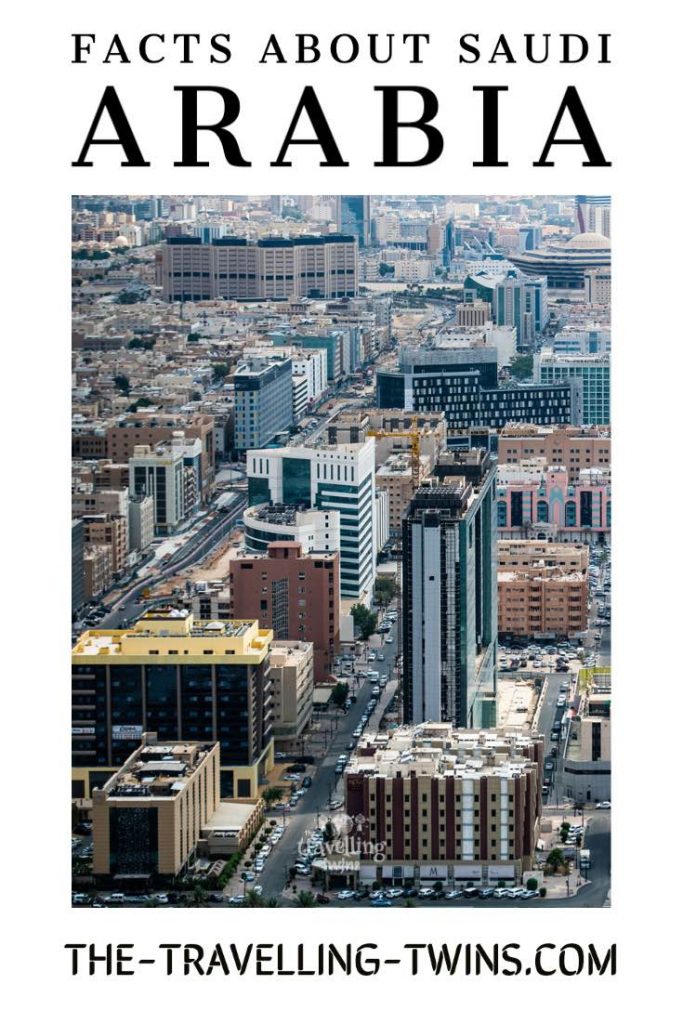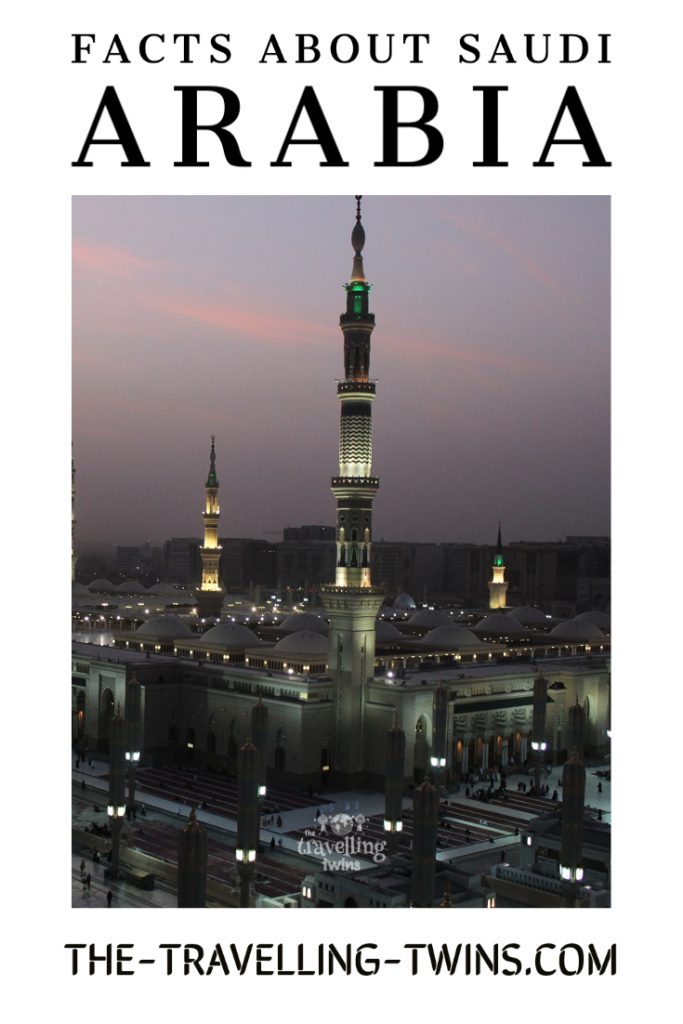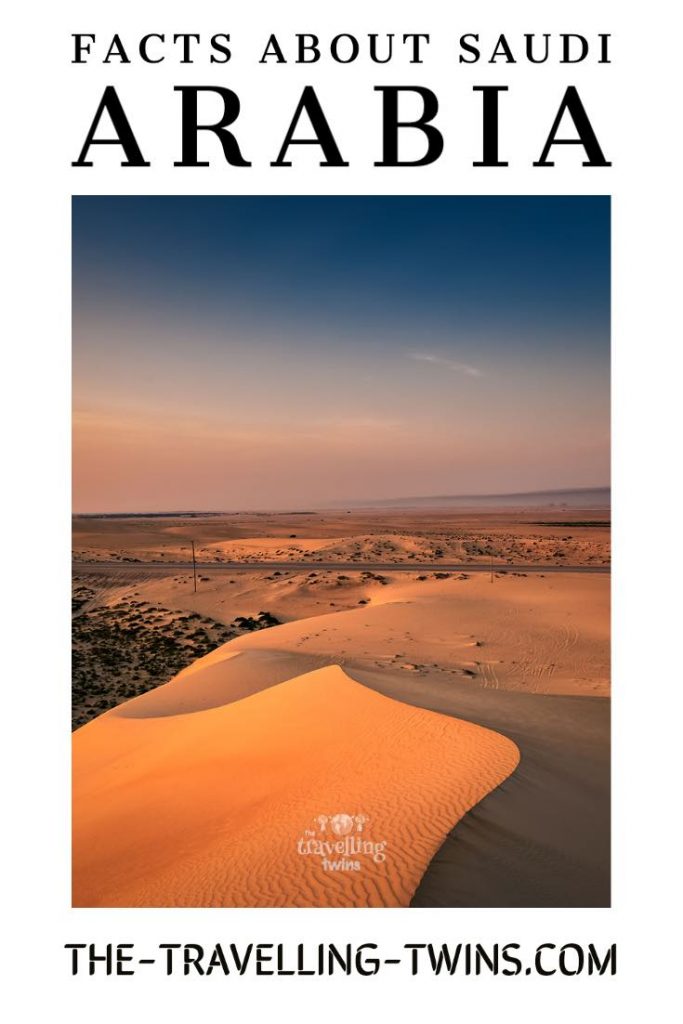The Kingdom of Saudi Arabia, also known as Saudi Arabia, Saudi or by the initials KSA, forms the core of the Arabian Peninsula in the Middle East. It is the world’s second-largest Arab country by area. It is also one of the wealthiest. Saudi Arabia is known for its connection to Islam, actively followed by over 90% of the population. These facts have led to Saudi Arabia becoming a major player in Islamic finance. Saudi Arabia’s natural resources are what make it wealthy: natural gas, petroleum and minerals. The majority of Saudi production comes from these resources. Still, with the world’s concern over the role of fossil fuels in accelerated global warming, the KSA is trying to diversify with investments in other sectors, including agriculture and tourism.
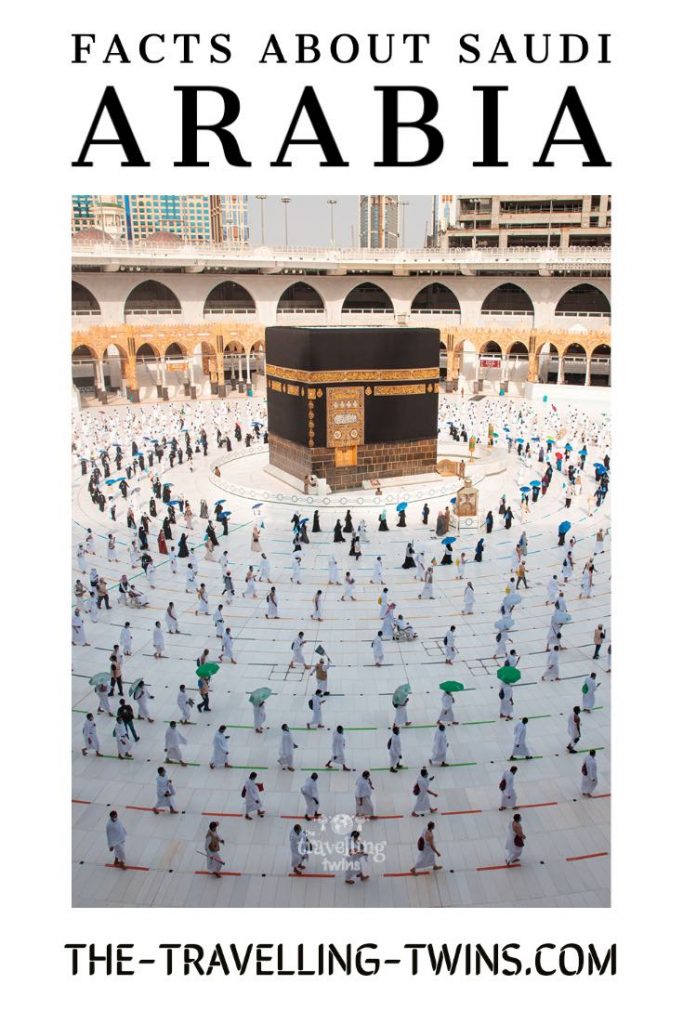
Saudi Arabia Location, Size and Borders
Saudi Arabia is located on the Arabian Peninsula, the world’s largest peninsula, and makes up most of its area.
It is the largest nation in the Middle East and the second-largest country in the Arab world by area after Algeria. It has a land area of 2,150,000 square kilometres (830,000 sq mi) and a population of 34 million, making it the sixth most populous of the 21 Arab states. Immigrants make up more than 35% of the population; they comprise mostly cheap labour from Southeast Asia and Africa.
Saudi has land (or bridge) borders with eight other nations. Clockwise starting from the northwest, it faces both Egypt and Israel across the Gulf of Aqaba (the Eastern finger of the Red Sea) but does not have land borders or road crossings with either of them. To the north, it borders Jordan, Iraq and Kuwait. Then facing the Arabian Gulf to the northeast, there are the two small nations of Bahrain (an island linked by bridges) and Qatar, a peninsula. Then the KSA faces Eritrea, Sudan and Egypt across the Red Sea, bringing us up again to the Gulf of Aqaba. Not bordering directly but facing Saudi Arabia across the Gulf is Iran. And finally, flanking the southeastern and southern end of the Arabian peninsula are the United Arab Emirates, Oman and Yemen.
“Winston’s Hiccup.”
The border between Saudi Arabia and Jordan deviates from a straight line by about 140 kilometres to the northwest in a sharp triangular area of 13,000 sq km to the benefit of Saudi Arabia. This great deviation is known as “Winston’s Hiccup.” It is true that Winston Churchill, later British Prime Minister, boasted that he had created the nation of Jordan “with the stroke of a pen, one Sunday afternoon in Cairo.” That was in 1921 when he was the British Colonial Secretary. Churchill was also famously fond of alcohol. The nickname of the strange shape, of course, suggests that the errant line was caused by his drunken inattention followed by a hasty correction, and this is almost certainly not true. The line of the border had already been extensively negotiated with the Arabs by another Brit with the unlikely name of William Shakespeare, and the form of the line took into account tribal boundaries and the strategy of managing hostilities between the Arabs and the Ottomans.
Saudi Arabia Geography Facts
The landscape of Saudi Arabia is primarily barren, but there are some oases scattered throughout the country, the most important of which are in “Wadi-al-Dawasir” and “Al-Qateef”. The Empty Quarter desert covers approximately two-thirds of Saudi Arabia and extends into Oman and the UAE. The Empty Quarter is the largest sand desert in the world. As an arid country with a subtropical climate, Saudi Arabia receives an average annual rainfall of only 100mm.
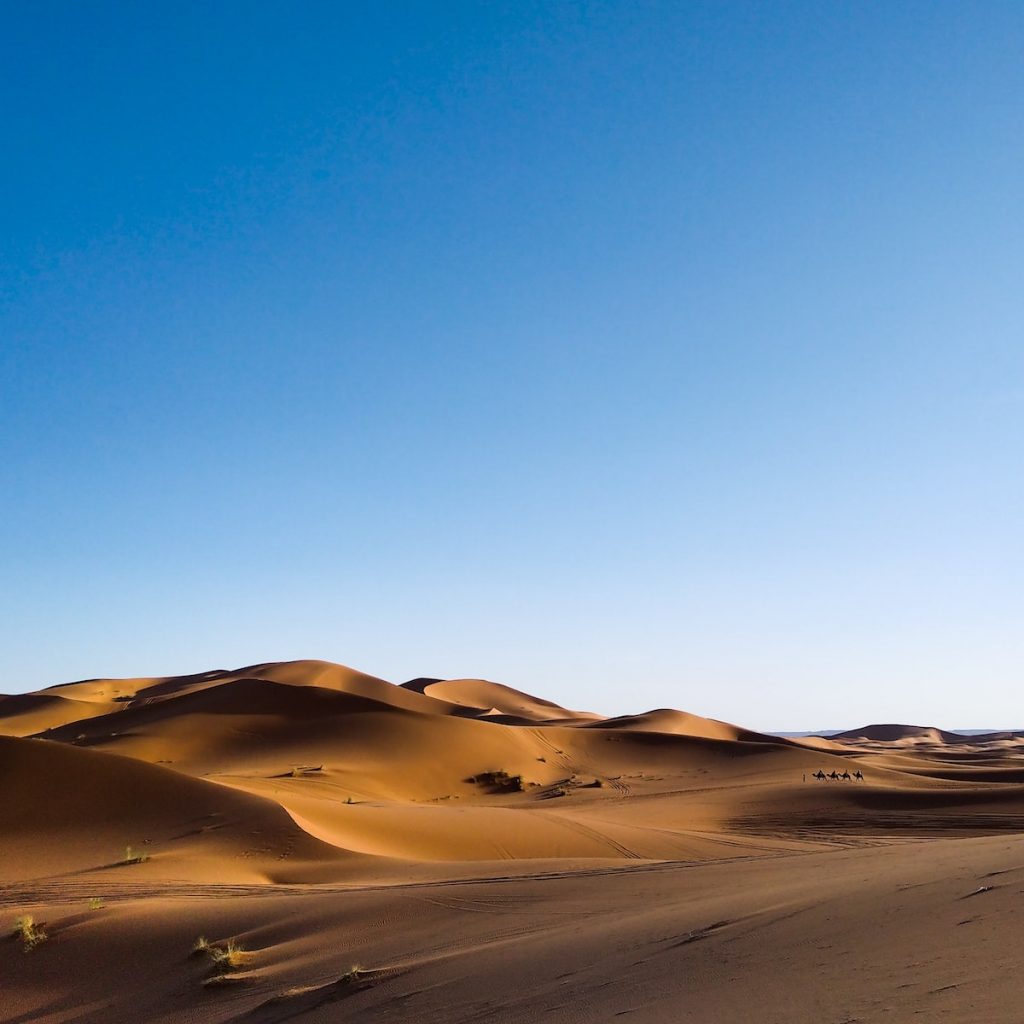
Saudi Arabia’s natural resources are what make it wealthy. Most obviously, they include petroleum and natural gas and minerals – with an estimated $1.3 trillion worth of mining resources including gold, copper, aluminium and phosphates. After petroleum, the nation’s second-biggest earner is the “downstream” processing of petroleum products, and after that, mining.
With the world’s concern about global warming and the position of petroleum in that equation, Saudi is actively diversifying with investments in other sectors, including agriculture and tourism.
Brief History of Saudi Arabia
The Arabian Peninsula has a long and rich history, which can be traced back to the 3rd millennium BC. The first major civilization to arise in the region was the Dilmun Civilization, which was centred around what is now Bahrain. The Dilmun civilization was followed by the Umayyad Caliphate, which rose to power in the 7th century AD and controlled a large portion of the Middle East.
In the early 18th century, a series of dynasties known as the Wahhabi emerged in Saudi Arabia and eventually succeeded in unifying the peninsula. The Wahhabi dynasty lasted until 1926 when it was overthrown by the House of Saud. The House of Saud has ruled Saudi until the present, despite an abdication and an assassination within the family.
Saudi Arabian Currency
The currency in Saudi Arabia is the Saudi Riyal, subdivided into 100 halalas. The value of the Saudi Riyal is fixed as 3.75 riyals to the US dollar, an arrangement that has been in place since 1986. Banknotes are issued in denominations of from SR200 to SR10, while coins are available in denominations down from SR25.
Saudi Arabian Culture
Saudi Arabia’s culture is known for its strict connection to Islam, which is practised by over 90% of its population. (almost all the Arabs and most of the immigrants) This connection has led to Saudi Arabia being a major player in Islamic finance according to Shariah law which prohibits lending for interest – the way this financial model works is that the bank buys the product or property, and then the customer buys it back from the bank with stage payments at a higher price.
The official language in Saudi is Arabic, but English is frequently used in business. The reason that there are frequently alternative western spellings for many Arab words is that there is no direct correlation between many sounds in Arabic and western languages. For example, you will often see spellings including Kh G and Q (without a following u) to represent a collection of consonants that sound different to Arabs but the same to anglophones, whereas the Arabic language has only one sound (and one letter) to share between our oo, u, o, and the “a” sound in “ball”. My husband was asked why he called his colleague “Doug” a dog, and our daughter Zoe found that the “oe” in her name was spelt the same as the “oy” in Toyota. No surprise then that you will find thobes also written as thawbs or eqal as agal – the spellings are, of course, consistent in the original Arabic script.
To make Arabic even more confusing to westerners, it is famously written from right to left, several letters have different forms if placed at the beginning, end or middle of a word, and written Arabic frequently leaves out vowels that are clearly spoken (Unlike my native Polish, where if there are a collection of consonants following each other (like “sprz” or “przyst” for example), then they are all pronounced together as one sound without any vowels at all! The Arabic we commonly see written or printed is a simplified form, but all the intonations and special sounds can also be added back in as dots, and small accents and Arabic calligraphy is also frequently written in non-linear shapes to create geometric or floral shapes.
Facts about Saudi National Dress
Saudi women typically wear a black abaya, a long cloak covering their bodies from head to toe. They also wear a black headscarf and veil covering their hair and face. Saudi Arabia’s religious police ensure that all women are wearing an abaya and wearing it in a way that is not too fancy or revealing.
Men typically wear a dishdasha or thobe, a long white robe, and a headscarf or ghitra. The Chitra is either white or of a red and white checkered fabric. It is held in place by a double black ring of rope called the eqal. The eqal has its roots in a hobble used to prevent camels from straying. The Saudi thobe differs from those of other Gulf States by having cuffs, usually designed for use with cufflinks and a stiff buttoned collar without wings.
Saudi Arabia and Islam
Saudi is home to two of Islam religion’s holiest cities Mecca and Medina.
Mecca is believed to have been founded by Prophet Abraham and his son Ishmael according to Islamic texts, and it is also home to the holiest site in Islam- Haram al-Sharif. Mohammed was born here and lived here to the age of 53. It is the destination of the Hajj – the pilgrimage which all Muslims are required to make at least once in their lives.
In Mecca, Haram al-Sharif, which literally means “The Noble Sanctuary” or the “Sacred Site”, contains the ‘Kaaba’, a building at the centre of Islam’s most sacred mosque Al-Masjid al-Haram.
Medina simply means city in Arabic, so the Saudi city medina is a short form of its full name Al-Madīnah al-Munawwarah (“The Luminous City”) where Mohammed moved to from Mecca, where he founded the first Muslim community and where he is buried.
Mohammed moved to Medina in 622 CE, making this the year zero on the Islamic calendar; however, Islamic years are measured in twelve lunar months, so they are shorter than the solar years used by the rest of the world. This affects not only the timing of Islamic annual feasts and fasts but also the calculation of the year number.
What is illegal in Saudi Arabia?
Homosexuality, adultery, prostitution, drug use and possession are all illegal. Punishment for these crimes is very harsh in Saudi Arabia, with many offences resulting in the death penalty or life imprisonment. The death penalty was applied for crimes committed by minors until 2020. Saudi Arabia is one of four countries in the world that still carries out public executions.
It is illegal to possess, drink or brew alcohol, either as a tourist or a resident, and during the month of Ramadan, it is illegal to eat or drink in public before sunset.
Photography of military or police buildings and palaces are illegal as in many places worldwide. You also shouldn’t take pictures of local people, especially women.
Binoculars which can capture images or night vision binoculars are illegal. In fact, no binoculars can be brought to Saudi. Surprisingly, private citizens and visitors are allowed to fly drones. However, you will require a special import license to bring your drone into the country, and there are strict rules covering their use.
In Saudi, it’s illegal to have two passports. If you show that you have two passports, one of them will be confiscated.
Only in the last decade has Saudi Arabia allowed women to drive and to vote. However, women still have to gain written permission from their father or another male guardian (usually their husband) to apply for a passport, travel abroad, get married, open a bank account, start a business, have surgery, or . . . leave prison.
Facts about the Saudi Royal Family
Saudi Arabia remains an absolute monarchy. The Saudi king’s official title is the “Custodian of the Two Holy Mosques.”
King Salman bin Abdulaziz Al Saud has ruled Saudi Arabia since 2015 and is listed by Forbes as one of the world’s ten most powerful people.
The House of Saud has controlled Saudi Arabia since its formation in 1932 and continues to rule as the royal family of the country. Their power is enforced by a committee or Majlis Ash-Shura that can remove any members who violate their laws.
Saudi cuisine
Saudi cuisine is similar to that of the surrounding countries in the region and includes lamb, goat, chicken, rice, vegetables, dates and figs. In general, (non-alcoholic) drinks are an important part of Saudi culture. Coffee shop chains like Starbucks have been very popular throughout Saudi Arabia for years.
Saudi Arabia Economy
Saudi Arabia’s most significant export partner is China, followed by Japan, then India, then South Korea. It imports goods primarily from China, the United States and Japan, with oil making up 87% of exports between 2008 and 2014
Saudi Arabia has built its wealth by selling oil. It is the largest exporter of petroleum in the world, although Russia soon may take that title away. This has made Saudi Arabia a very influential country in terms of international policy and economies around the world thanks to their control over the price of oil, which impacts all sectors of the economy.
Saudi Arabia is considered a “developing” country, but the human rights situation in Saudi Arabia leaves much to be desired, especially with women and minorities. It was ranked 143 of 188 countries on the Human Development Index (2015) and has also been criticized for its abysmal record on press freedom by Freedom House (2016), and according to Reporters without Borders (2016), the country ranks 159th out of 180 countries on press freedom. The World Economic Forum ranked Saudi Arabia 130th out of 144 on gender parity in 2015
Interesting facts about Saudi Arabia Fun Facts
Prince Sultan bin Salman bin Abdulaziz Al Saud was the first Muslim and Arab astronaut. He also holds the world record for flying the longest flight in a helicopter at over 1,000 kilometres.
Saudi Arabia banned smoking in public places and government offices.
Only Muslims can get Saudi Citizenship.
Saudi is trying to beat the record for the tallest building in the world now held by Burj Khalifa in Dubai. Jeddah tower, once completed, will stand at the height of 173 floors and 1,000 meters! The Jeddah tower Project is currently on hold.
Saudi Arabia has one of the highest rates of Twitter use in the world, with an estimated 24 million active users.
Saudi Arabia Facts – Pin it for later
Saudi Arabia Government
